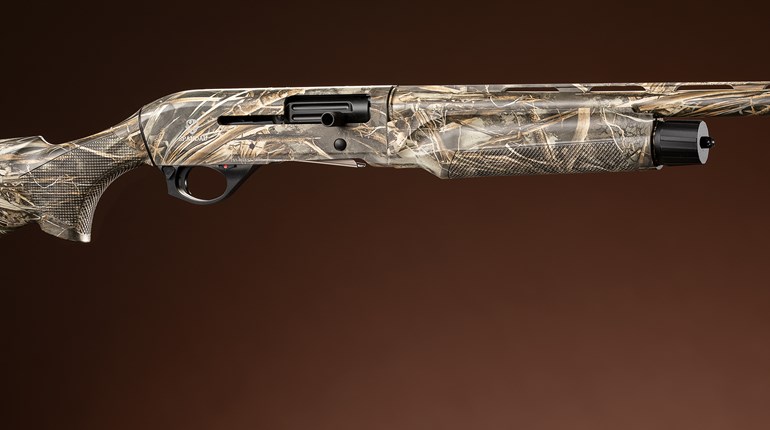
Competition shooters are always willing to consider a new technique or device that might add a few points to or chop a bit of time off our performance. Upgrading Ruger’s 10/22 to “run and gun” and precision competition level is a specialty at Tandemkross, where engineers packing four major improvements into its 10/22 Manticore trigger housing offers shooters an edge.

For a rifle gearhead appreciative of fine machine work, opening the Manticore box is accompanied by a bright light shining down from the heavens and a chorus of cherubs singing hallelujahs. It doesn’t hurt that the Manticore’s aluminum controls are anodized shiny red, like a new fire engine, which contrasts nicely with the black aluminum housing. But the Manticore’s beauty isn’t just skin deep, it goes all the way to the functional core.
In this single drop-in unit, Tandemkross has upgraded the trigger to an adjustable model, simplified bolt closure to one-handed operation, and made both safety and magazine release operable by the trigger finger rather than the thumb. Those last three alone can shave one or more seconds across a course of fire or a match, and the adjustable trigger opens up other competition games for the 10/22. Here are individual rundowns on each of the Manticore’s competition features.
TWO-WAY MAG RELEASE
First and most obvious is that massive dual-directional Fireswitch extended magazine release. “Dual-directional” means the operator can either pull or push the release to drop magazines during fast-paced competition; at the conclusion of shooting, pushing the release forward with the thumb allows the magazine to drop into the open hand. The enlarged, paddle-shaped surface area is an aid when wearing gloves.
In pulling the release backward, it feels a bit spongy, a function of its hinged levering design; pushing forward feels more positive as it acts directly on the magazine latch plunger. More importantly, I found I could push the magazine release with my trigger finger without the need to shift my shooting grip. Testing the release with eight different new and used magazines, including double mags and a 15-round curved magazine, all fell completely free of the gun without a hitch, whether pushing or pulling the release.
LOOK MA, ONE HAND!
Fumbling with our gear in competition can put our names lower on the list of match results—it’s happened to all of us. When it comes to speedy or intuitive operation, and for anyone new to the 10/22, Ruger’s minuscule factory bolt lock is a poor feature from an ergonomic aspect. In my experience, virtually every first-time shooter of the factory 10/22, whether or not experienced with other firearms, is at first baffled by the bolt lock and then continues for some time to fumble with finding, engaging and disengaging it.

Ruger’s 10/22 bolt lock requires two hands to engage or disengage, one on the lock and the other pulling backward on the bolt handle. With both hands breaking their grip and thus occupied, the shooter needs a third hand to safely hold the rifle. Tandemkross’s Bolt Keeper Extended Bolt Lock joins a proprietary lock (an angled piece of stamped metal, as is Ruger’s factory bolt lock) with a knurled knob that threads onto its left side. With the bolt held open by the bolt handle, pull backward on the lock’s knob to engage; but to disengage, simply pull back on the rifle’s bolt handle and release it. The bolt closes every time, with a loaded magazine, an empty magazine or no magazine.
LIKE AN AR-15
Crossbolt safeties are perfectly adequate for hunting or plinking purposes, but they can be a liability in competition as they may require breaking grip with one hand or the other to either push on or push off, which can cost time and focus. Every AR-15 shooter will intuit the flip-up, flip-down Tandemkross Cornerstone Rotary Safety. Fully ambidextrous, the safety levers throw easily and indent positively without having to overcome excessive spring tension. Small scallops milled into the back side of the trigger guard on each side ensure either thumb can push the levers forward far enough to confidently disengage the safety.

However, I found it quicker to push the lever off with my trigger finger—and, again, it doesn’t break my shooting grip. Pushing the levers forward/down to disengage, they feel as though they “cam over” at about the halfway point to snap forward on their own. Another bonus is that, unlike push button safeties, a range safety officer can visually determine whether the rotary safety is engaged when the shooter is moving from firing point to firing point.
ADJUSTABLE TRIGGER
Tandemkross and other manufacturers sell drop-in trigger kits for the 10/22 that reduce pull weight down to a fixed two to 2½ pounds or so. While lighter is usually better for precision shooting, some competitions require minimum pull weights, such as 3½ pounds, so those lighter, fixed trigger weights aren’t going to qualify.
Manticore differs in featuring a trigger that adjusts from two to five pounds. This feature is machined into the Manticore’s aluminum housing; while the Manticore in its entirety will drop into a Ruger 10/22 receiver, the Manticore’s Weight and Travel Adjustable Ultimate Trigger Kit will not drop into a Ruger trigger group housing.

Access to the weight adjustment screw is through the top of the Manticore and is visible left of the hammer. Adjustment requires turning the screw, installing the Manticore in the receiver and testing the pull weight. If needed, remove the Manticore and repeat. Tandemkross strongly cautions against pulling the Manticore’s trigger when it is not installed in the receiver, as it could cause damage or springs and parts to go flying.
The trigger kit includes hammer and sear made of tool steel, with engaging surfaces EDM-cut to redesigned precise angles. The trigger is wide and flat-faced, with an overtravel adjustment screw. The trigger return spring is completely unlike the factory spring-and-plunger setup, eliminating the plunger and being tucked up inside the housing.
EASY DROP-IN
Before installing the Manticore, it’s necessary to first remove the rotary safety’s two levers and the Bolt Keeper Extended Bolt Lock knob, as these extensions will prevent the Manticore from sliding down into the stock. Tandemkross includes a Torx T10 wrench in the box for this operation.

Installing the Manticore is as simple as turning out the rifle’s takedown screw, pulling the barreled action from the stock, pushing out the factory trigger assembly’s two retaining pins, swapping it out for the Manticore and reassembling in reverse order. The Bolt Keeper Extended Bolt Lock Knob is held to the lock with only a few threads, so a drop of blue thread locker on reassembly is in order.
TO PINCH OR NOT
Let’s be frank here. At $375, the Manticore trigger assembly exceeds the cost of a basic Ruger 10/22, and there are less expensive trigger and trigger assembly upgrades from other makers that are less than $100 to about $300 and more. As well, it is possible to safely lighten the pull weight of factory triggers somewhat with careful polishing and stoning. But the Manticore is not just a lightened, adjustable trigger, and no one else’s upgrade offerings have all the competition features of the Manticore—not the least of which is being completely left-handed friendly.

If pinching pennies, the combined individual costs of Manticore’s four outstanding upgrades as shown here—the dual-directional Fireswitch Extended Magazine Release, Bolt Keeper Extended Bolt Lock, Ultimate Trigger Kit and Cornerstone Rotary Safety—totals $290, less than some other trigger assembly upgrades that don’t include a rotary safety or extended bolt keeper knob. And these Tandemkross upgrades will all drop right into a Ruger factory plastic trigger assembly housing. (Note the separate Ultimate Trigger Kit has a fixed pull weight of about two pounds; if you want an adjustable-weight trigger, you’ll need the Manticore.) But if we’re spending $300 anyway, why not pay another $75 for the adjustable trigger and Manticore’s rugged aluminum housing?
Getting into competition—or a new discipline—is more often incremental than all-in at once, and cost is usually a deciding factor. While we might have the means to pay cash for an out-of-the-box competition gun, sometimes it pays to buy a basic factory gun and upgrade it as we desire or can afford. This is especially applicable if we are crossing over from one discipline to another. There are many manufacturers turning out quality upgrades for America’s favorite .22, but Tandemkross is probably the most innovative and offering the most upgrades available in one place, and at reasonable prices. Learn more at tandemkross.com.


































